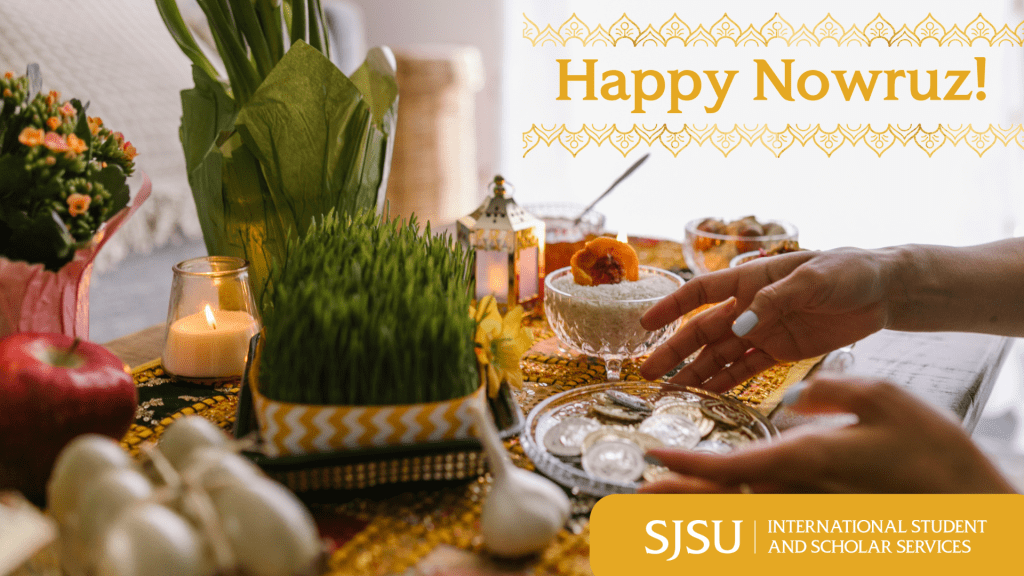
Persians and others around the world will wake up to a clean house, a festive table with hopes and aspirations for a new year, at 2:24pm PST on Monday, March 20th, 2023, the exact moment of the spring (or vernal) equinox. As an Iranian-American, I look forward to celebrating the Persian New Year each year with my family. I eagerly await the smell of the freshly-baked traditional sweets, like baklava and rice cookies, the aroma of the delicious food, saffron rice with herbs and smoked fish, and the sweet smell of the hyacinth flowers.
Nowruz or “new day” is a celebration of the arrival of spring, the rebirth of nature and the start of a new year. Nowruz dates back to many centuries ago and is a celebration shared by Iranians all around the world, but also celebrated in other countries, including Afghanistan, Azarbayejan, India, Iraq, Kazakhstan, Russia, Tajikistan, Turkey, Turkmenistan, and Uzbekistan.
In the lead up to the new year, people engage in cleaning their house and getting rid of the “bad” luck from the year before. In addition, on the final Wednesday eve, Persians celebrate “chaharshanbeh soori”, where they gather with friends and family around a bonfire. As they jump over the fire, they chant a phrase which is a symbolic request asking that the fire take away their bad luck and to bring in all the good luck for the new year. Here is a quick video showing some folks enjoying the celebration and jumping over the bonfires.
Nowruz itself is recognized by a symbolic table that is set called Haft-Seen, which means seven Ss. The table includes at least seven items that begin with the sound “S”; each item has a symbolic meaning. Below is a sampling of items that can be used:
- Sabzeh (sprouts) represents rebirth
- Seeb (apple) represents beauty
- Sekeh (coins) represent wealth and prosperity
- Serkeh (vinegar) represents wisdom and patience
- Seer (garlic) represents health
- Senjed (oleaster) represents love
- Sonbol (hyacinth) represents spring
- Sumac represents sunrise and/or spice of life
We also include a mirror on the table, representing reflection, goldfish representing life, colored eggs representing fertility, sweets and flowers and either a prayer book or a book of poetry from Hafez or Rumi. This BBC video (2019) provides a nice summary (Please note that this year, we are celebrating the year 1402 and not 1398).
Once the first day of Nowruz arrives, the 13-day celebration and gatherings with family and friends commence. People normally visit one another, exchange gifts and enjoy meals together. On the 13th day, people go out and picnic together. This act also symbolizes getting rid of the bad luck of the previous year and bringing in good luck for the new year.
As we embark upon this new year, I hope that you will find time to call a friend, spend quality time with a family member, smell a flower, indulge yourself in a sweet and to enjoy all that our new normal has to offer. Let us embrace the values of Nowruz and begin this new year of 1402 by continuing to advocate for peace, tolerance and solidarity. This year especially, for all Iranians, our slogan continues to be: “Women, Life, Freedom”. As we Persians say, Nowruz Pirooz (literally meaning may your new day be victorious)!
p.s. In commemoration of Nowruz, Representatives Zoe Lofgren (D-CA) introduced a resolution (H.Res.237) in the House of Representatives on 03/16/21 recognizing the cultural and historical significance of Nowruz and wishing Iranian Americans, the people of Iran, and all those who celebrate the holiday a prosperous new year.